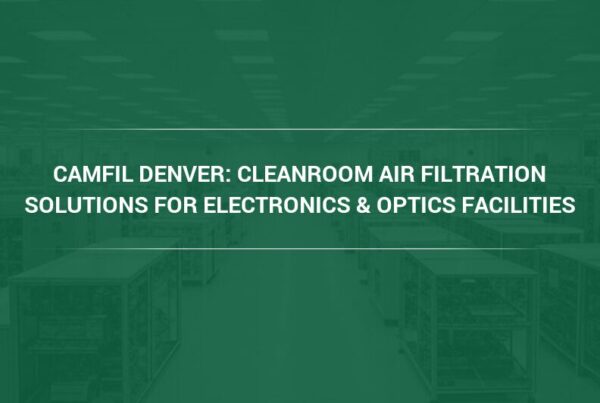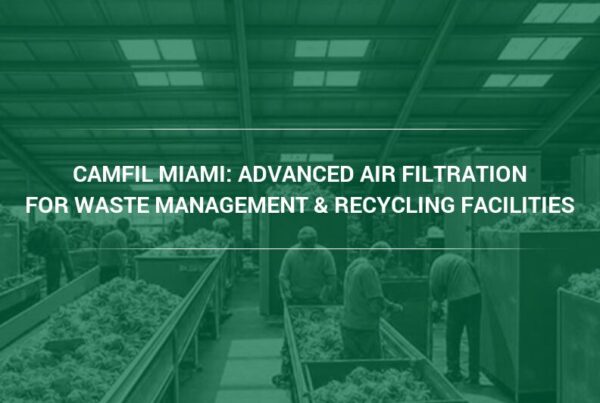Air quality in dental offices, like any healthcare facility, plays an important role in healing. Maintaining good indoor air quality is critical to good oral health, especially when patients have their mouths open for extended periods of time.
When dentists and hygienists are caring for patients, whether through routine cleaning or more invasive dental procedures, the right air filters will reduce the presence of airborne contaminants, which not only benefits patients but also dentists and staff. Of course, dental practices also have to meet regulatory compliance standards to ensure a safe environment.
Let’s take a closer look at the importance of air quality in dental offices, the need for high-quality air filters, the challenges to maintaining clean air and the types of air filtration solutions and strategies available.
Air Quality in Dental Offices: Why It Matters
Maintaining good air quality in dental offices can reduce the risk of infection and illness caused by exposure to contaminants through the air and on dental instruments. Dentists, hygienists, and staff are also susceptible to health problems that can be traced back to airborne contaminants.
Because dental procedures can produce airborne particles and hazardous aerosols that can be inhaled, proper air filtration and ventilation are needed to remove these substances from the air. Patients who suffer from respiratory conditions such as allergies and asthma can experience physical discomfort, breathing difficulty and fatigue when exposed to harmful substances in the air.
Unpleasant odors from a variety of sources such as dental materials, biological substances and cleaning solutions can make people feel uneasy and nervous. Given the fear that many people associate with dental visits, effective air quality management can help put the patient at ease by reducing or eliminating odors.
Beyond the health of patients and dental staff, safety standards must be satisfied to meet regulatory requirements for infection control, transmission-based precautions and proper cleaning and disinfection. Air filtration, air filter efficiency, ventilation, air changes per hour, staff training and air quality monitoring and recordkeeping are all key components of a comprehensive compliance strategy.
Potential Airborne Threats in a Dental Environment
A dental environment is susceptible to most of the same contaminants that can be found in any indoor environment, such as viruses, bacteria, allergens and dust particles. However, many substances are unique to dental environments and must be filtered continuously to maintain clean air and meet compliance requirements.
Saliva, blood and oral fluids can enter the air as aerosols and potentially spread airborne infections. This can occur during routine cleaning, scraping of plaque, drilling and other dental procedures. Endotoxins released by bacteria can increase the risk of fever, nausea, vomiting and other health issues.
Dental materials such as amalgam fillings can release mercury into the air, which can be harmful to the nervous system and kidneys. Some materials used to create an impression of the patient’s teeth can produce mercury vapor. Even asbestos, an ingredient found in older dental resins and impression material, can increase the risk of respiratory disease.
While disinfectants are necessary to clean various surfaces in dental offices and treatment rooms, the chemicals used to kill contaminants can be dangerous. Disinfectants can irritate the skin, eyes and respiratory tract and cause allergic reactions. Some disinfectants are toxic if inhaled or ingested.
Air Filters: Tailored for Dental Settings
Commercial HVAC systems continuously recirculate air inside the facility while adding a small volume of air from outside the facility. In addition to capturing particles brought in from the outside, air recirculated s within dental offices contains contaminants from dental procedures and patients and staff themselves that require filtering.. The air is drawn into the air filter by a fan and contaminants are captured as air passes through the filter and clean air is recirculated into the room.
There are different types of filters that are commonly used in dental offices:
- HEPA filters. High-efficiency particulate air (HEPA) filters tested and certified to a minimum efficiency level of 99.97% on 0.3-micron-sized particles.
- MERV filters. Minimum Efficiency Reporting Value (MERV) filters are rated on a scale of 1 (largest particles) to 16 (smallest particles).
- Activated carbon filters. Activated carbon filters utilize a technique known as adsorption to remove gas, odors, volatile organic compounds (VOCs), and other molecular contaminants from the air.
These types of air filters are generally used to protect the air in in dental treatment rooms but can also be used in other office areas, such as x-ray rooms and reception, to maximize effectiveness and prevent cross-contamination.
Challenges of Ensuring Optimal Air Quality in Dental Practices
As discussed previously, there are many types of contaminants in a dental environment. Viruses, bacteria, allergens, dust particles, aerosols formed from saliva, blood, and oral fluids from the patient, mercury vapor from dental materials, cleaning disinfectants, and various odors make proper air filtration in dental environments fairly complex.
Because aerosols and other types of airborne pollutants can be suspended in the air for a period of time, and patient turnover is fairly frequent in dental offices, there is an increased risk of these contaminants spreading. While dentists and staff can wear protective gear to reduce risk, patients are largely exposed.
Also, dental offices are typically small and part of a much larger facility, which can make it difficult to install the appropriate air filtration and ventilation systems. X-ray rooms, dental surgery suites and treatment rooms in particular require more advanced systems and air filters with higher ratings than the average office space. Designing a system to meet the specific demands of specialized spaces can be difficult.
Selecting the Right Air Filter for Dental Offices
There are many factors to consider when choosing air filters for dental offices. Start by answering the following questions.
- How big is your dental office?
- How big are the rooms that have strict air filtration requirements?
- What types of procedures are performed?
- What types of contaminants need to be removed?
- What is your average daily patient volume?
- What is your patient turnover frequency?
- How is maintenance handled?
- What is your budget?
Air filters need to be paired with the HVAC equipment to maximize efficiency and the right type to ensure effective removal of the most common contaminants in dental offices. The system will need to be configured to keep up with patient turnover. Of course, air filters need to be changed and systems maintained, so processes and filterlifespan need to be considered when choosing air filters specifically for a dental environment.
Emerging Innovations in Dental Air Filtration
Given heightened sensitivity to airborne contaminants and the spread of disease since the pandemic, dental practices and all healthcare facilities have been under pressure to implement more sophisticated air filtration and ventilation solutions. Innovation is a business imperative, and the industry is responding.
Some HVAC systems use internet-connected sensors and artificial intelligence (AI) to monitor the air to ensure it meets compliance standards. Modern systems can provide real-time data on air quality, automatically adjust fan settings as needed and send alerts to technicians if air quality dips below a certain threshold and maintenance or repairs are needed.
The capabilities can reduce exposure to harmful contaminants. The data generated by HVAC systems equipped with sensors can predict potential problems before they happen and optimize air quality.
Installation and Upkeep: A Dental Perspective
Once the right air filters are chosen, they should be securely installed in an unobstructed location by a qualified technician. Properly installing air filters in systems that supply air to treatment rooms, waiting rooms, and reception is essential to maximizing effectiveness and efficiency. Follow the manufacturer’s instructions when installing as well as removing old filters for disposal.
Like any equipment and technology, HVAC systems and air filters should be maintained regularly. Gaskets should be inspected to ensure they are sealing and preventing bypass. Generally speaking, air filters should be replaced based on pressure drop and by the number of weeks or months they’ve been in service. The cost of energy to power the fan in an HVAC system is the single highest cost component of an air filtration program. Assuming the correct MERV value has been selected, air filters that maintain the lowest average resistance to pressure drop deliver the lowest total cost of ownership.. HVAC equipment should be inspected according to the manufacturer’s recommendations. .
Conclusion: Prioritizing Clean Air in Dental Care
Unlike most other types of healthcare practices, dental environments are home to procedures that have a direct, immediate impact on air quality. At the same time, dental practices face intense scrutiny to maintain a safe environment for staff and patients and meet compliance requirements that will likely increase in number and complexity.
With unique air quality challenges, a wide range of contaminants, and very strict compliance requirements, proper implementation and maintenance of highly effective air filtration and ventilation solutions are an absolute necessity. At the same time, continued research and innovation are needed to capture the smallest contaminants while maximizing efficiency and sustainability.
Recognizing the important role air filters have in dental care, Camfil will continue to be a strong advocate for these efforts. Camfil partners with dental practices and property managers to design, install, and maintain air filtration and ventilation systems that meet the unique needs of the industry. Clean air in dental environments must remain a top priority, and Camfil will continue to step up with strategies and solutions that ensure safety and compliance.



